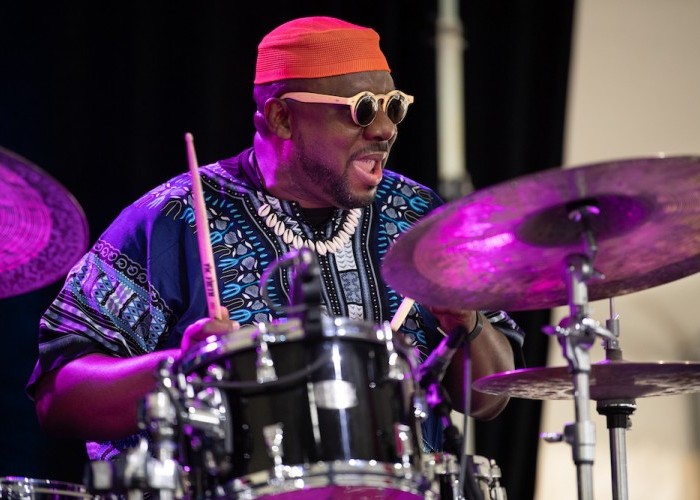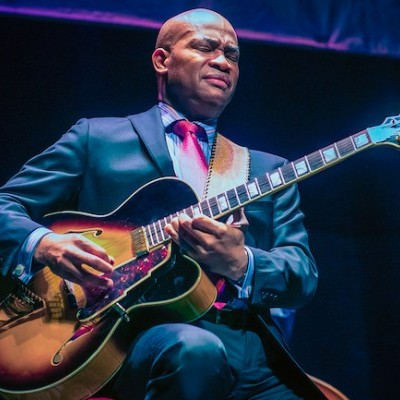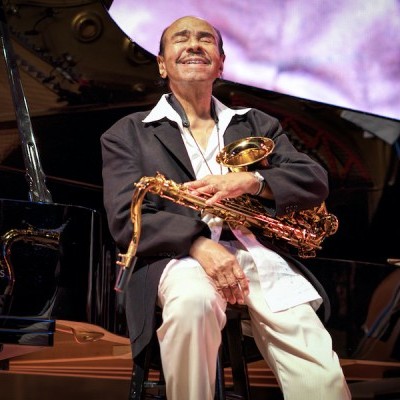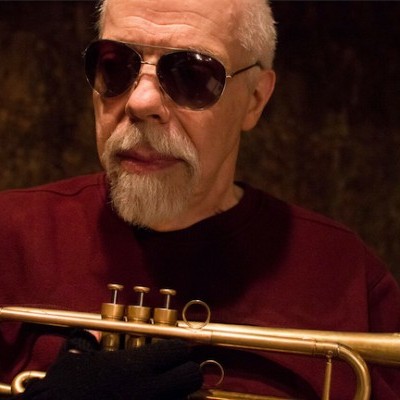Aug 27, 2024 12:09 PM
Remembering Russell Malone, 1963-2024
Guitarist and bandleader Russell Malone died Aug. 23, while on tour in Japan, after battling end-stage kidney failure.…

Ralph Peterson teaches at Berklee College of Music in Boston.
(Photo: Steven Sussman)On a hot August afternoon in Boston, Ralph Peterson greets an incoming class of freshmen for orientation week at Berklee College of Music, where the drummer-bandleader-composer-educator has been teaching for 16 years. An imposing presence decked out in colorful African garb, he strolls across the front of the classroom, scribbling notes on the white board while intoning historical facts like a preacher addressing his flock.
“Congratulations! You guys have accomplished a lot by arriving here. You are the best in your communities, the best where you come from,” he tells the students. “My job is to fuel your hunger, create more questions in your mind. And my goal is for you to leave with a sense of empowerment.”
Professor Peterson presides over the class of 20 fresh-faced students, some of whom barely know who Miles Davis was, let alone Peterson’s own mentors Paul Jeffrey and Michael Carvin, or his ultimate role model, Art Blakey. As he would later say, “They’re so young, they don’t know that they don’t know.”
For this primer on jazz history, Peterson is tasked with squeezing 100 years of information into a 105-minute talk. Because the class is made up entirely of African-American students, he pulls no punches about where the music comes from, tracing the slave trade from the west coast of Africa to Brazil, the Caribbean, Cuba, Puerto Rico and finally New Orleans.
“Now, what was the first thing they took away from us when we got here?” he intones.
One student speaks up: “Drums!”
“Yes, the original cell phone: drums. Now, when I say New Orleans music, who is the patriarch? He was the first great improviser and the first great jazz vocalist.”
A chorus of voices chimes in: “Louis Armstrong!”
“Right. Can someone name a song that Louis Armstrong was famous for?”
Hearing no answers, Peterson plays a recording of Armstrong singing “What A Wonderful World,” and a few nod their heads in recognition.
Peterson continues his rapid-fire grilling of the class: “Who was from D.C. and became jazz’s most prolific composer? Who was known as ‘The Kid From Red Bank’? Who was the drummer with Fletcher Henderson and became one of the greatest bandleaders in jazz? Who was the young trumpeter out of St. Louis who played with Charlie Parker and turned the entire jazz world on its ear—not once but five times?”
As he continues quizzing his students, the white board in the front of the class begins filling up with facts about how New Orleans funerals blend spirituals and the second line, about military bandleader James Reese Europe being the link between ragtime and jazz and how Bird begat Miles and Miles begat Trane. The students hang on his every word.
Adroitly and without any notes, Peterson catalogs early bandleaders—from Fletcher Henderson to Chick Webb to Lionel Hampton and Panama Francis—then addresses bebop as “the music of rebellion, the hip-hop of its day.” He plays Billie Holiday’s “Strange Fruit” as an example of protest music and showcases Johnny Hodges’ playing on “Isfahan” as an example of classic Ellingtonia. He runs down Bird and Diz, covers Count Basie and his arrangers Frank Foster and Quincy Jones. He even delves into electric Miles, cuing up “Spanish Key” from 1970’s Bitches Brew and “Splatch” from Davis’ 1986 album Tutu; the young members of the class bobbing their heads in solidarity with the groove.
At a key point in his lecture, things turn personal. “I was the last drummer to be chosen by Art Blakey to play as a Jazz Messenger in his two-drummer Jazz Messenger Big Band,” he tells his young charges. “Our first gig was at the Berklee Performance Center in March 1983. My job was to mimic and shadow and play with Art Blakey. He was my teacher and taught me playing music was a service position. What I serve is the music, not my ego.”
Peterson next shows the class a picture of himself standing next to his mentor Blakey from back in the day, describing the young person in the picture as a 158-pound crack addict. “The good news is that I was a crack addict and that I am no longer,” he tells his students. “Thank God I’m 22-and-a-half years clean.”
After class, back in his Berklee office, the drummer reflects on other obstacles he has overcome. He has persevered through four cancer surgeries, follow-up radiation and chemotherapy in the past two-and-a-half years. “I guess it’s the Klingon in me,” Peterson laughs, alluding to the warrior race on Star Trek. “I’ve had enough chances to be dead, but I’m grateful to be alive. And the focus and intensity and pace at which I’m now working and living is directly related to the spiritual wake-up call that tomorrow isn’t promised.”
Despite visible scars and an emotional toll, Peterson remains determined to carry on without interrupting his teaching and gigging schedules. “People think that when you reach Stage 4 cancer, you automatically have to get your affairs in order, but it’s not true. Stage 4 just means that it’s moved from its original spot to someplace else. I now have Stage 4 liver cancer, and so we have deal with that. I have an amazing surgeon, an amazing hospital, and Berklee has supported me through my health challenges. I’m down with Berklee, because Berklee’s been down with me.”
“I have always been deeply impressed with Ralph’s commitment to his students,” wrote Dr. Lawrence Simpson, Berklee’s senior vice president for academic affairs and provost, in an email. “Whether his students are on the bandstand, in the studio or lab, Ralph is demanding, honest and generously giving. He understands his honored place in the jazz lineage and he is devoted to seeing that the tradition remains strong and that the music expands.”

In addition to his instrumental prowess, Malone was praised for his musical generosity and his singular sense of humor.
Aug 27, 2024 12:09 PM
Guitarist and bandleader Russell Malone died Aug. 23, while on tour in Japan, after battling end-stage kidney failure.…

Benny Golson soaks in the music during a late-career performance at Chicago’s Jazz Showcase.
Sep 24, 2024 12:02 PM
Benny Golson, one of the greatest composers and saxophonists of the bebop era, passed away Saturday, Sept. 21, at his…

Harpist Brandee Younger is among the performers on the program for this year’s Hyde Park Jazz Fest in Chicago.
Sep 17, 2024 11:40 AM
The 18th Annual Hyde Park Jazz Festival will be held on 13 unique stages across Chicago’s Hyde Park, Kenwood and…

Claire Daly, right, performs with tenor saxophonist George Garzone at Dizzy’s in 2023.
Oct 23, 2024 10:10 AM
Claire Daly often signed her correspondences with “Love and Low Notes.”
The baritone saxophonist, who died Oct.…

McNeil’s virtuosity as a player was unimpeachable and his imagination as an improviser was vast.
Oct 2, 2024 11:35 AM
John McNeil, a trumpeter, composer and educator who built an accomplished and progressive career in jazz despite a…